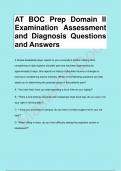AT BOC Prep Domain II
Examination Assessment
and Diagnosis Questions
and Answers
A female basketball player reports to your university's athletic training clinic
complaining of right superior shoulder pain she has been experiencing for
approximately 5 days. She reports no history of shoulder trauma or changes in
training or conditioning load or intensity. Which of the following questions can best
assist you in determining the potential cause of this patient's pain?
A. "You look tired; have you been spending a lot of time on your laptop?"
B. "That's a nice-looking and large new messenger style book bag; do you carry it on
your right or left shoulder?"
C. "I know you commute to campus; do you have a lumbar support roll in your car
seat?"
D. "When sitting in class, do you have difficulty seeing the projection screen or
blackboard?"
,✓~ B : A patient' s pain may be caused by activities of daily living that subject the body to
repetitive stresses. Backpacks that are heavy and worn on one shoulder can overload the
patient' s shoulders. Students should be instructed to use both shoulder straps while wearing
backpacks, avoiding carrying weight over one shoulder.
A n athlete with repeated herpes simplex eruptions should be counseled to avoid
which of the following potential outbreak triggers?
A. Fatigue, psychological stress, and sunlight exposure
B. Overexposure to the sun, decreased body fat percentage, and sharing water
bottles
C. Sexual activity, contact with others, and dehydration
D. Contact with others, fatigue, and a high carbohydrate diet
E. Poor nutrition, overexposure to the sun, and sexual activity
✓~ A: Herpes simplex eruptions can be triggered by illness, external stresses, internal
stresses, fatigue, overexposure to sunlight, menstruation, and physical trauma.
A baseball pitcher presents with unilateral shoulder pain he describes as deep within
the joint as well as intermittent bicipital groove and biceps tendon tenderness. The
athlete also reports a history of his involved shoulder popping, clicking, and catching
with certain motions. As he is a baseball pitcher, you are concerned he may have
sustained a superior labral anterior-posterior (SLAP) lesion. To apply evidence
based practice to the examination of this patient, what information from the National
Athletic Trainers' Association (NATA) position statement on evaluation,
,management, and outcomes of and return-to-play criteria for overhead athletes with
SLAP injuries should you consider?
A. Bicipital groove or biceps tendon tenderness is diagnostic of a SLAP lesion.
B. A history of popping, clicking, or catching is diagnostic of a SLAP lesion.
C. Mechanisms of injury for a SLAP lesion can include repetitive overhe
✓~ C: In overhead athletes, the mechanisms of a superior labral anterior posterior (SLAP)
lesion are associated with repetitive overhead activities. During overhead motions the tensile
forces on the labrum from the biceps during the deceleration phase may result in a tear of
the labrum
Which of the following groups of muscles insert into the medial aspect of the tibia just
distal to the medial condyle?
A. Vastus medialis, gracilis, and semimembranosus
B. Semitendinosus, sartorius, and vastus medialis C. Biceps femoris,
semitendinosus, and semimembranosus
D. Sartorius, gracilis, and semitendinosus
E. Sartorius, gracilis, and semimembranosus
✓~ E: Sartorius, gracilis, and semimembranosus muscles make up the pes anserine
muscle group and insert on the medial aspect of the tibia through a common tendon
Which four palpable bony prominences define the carpal tunnel?
A. Radial styloid, navicular, ulnar styloid, and hook of the hamate
, B. Radial styloid, base of the first metacarpal, base of the fifth metacarpal, and ulnar
styloid C. Pisiform, tubercle of the navicular, hook of the hamate, and tubercle of the
trapezium
D. Tubercle of the navicular, lunate, pisiform, and ulnar styloid
E. Lister' s tubercle, tubercle of the trapezium, capitate, and base of the fifth
metacarpal
✓~ C: The carpal tunnel is oriented within the carpal bones. The trapezium is the most
medial bone in the carpal distal row, and its prominence can be palpated through the
hypothenar eminence. The pisiform is also found and palpated on the medial portion of the
wrist. The carpal tunnel is defi ned laterally by the tubercle of the navicular and the hook of
the hamate
Which ligaments comprise the lateral ligaments of the elbow?
A. Radial collateral ligament, lateral ulnar collateral ligament, anterior oblique band,
posterior oblique band
B. Transverse oblique band, annular ligament, accessory collateral ligament, radial
collateral ligament
C. Radial collateral ligament, lateral ulnar collateral ligament, accessory collateral
ligament, anterior oblique band
D. Anterior oblique band, posterior oblique band, transverse oblique band, annular
ligament E. Annular ligament, accessory collateral ligament, radial collateral
ligament, lateral ulnar collateral ligament




